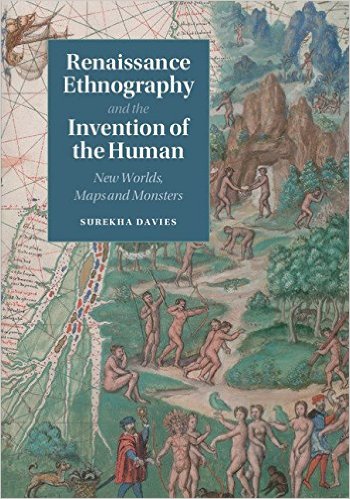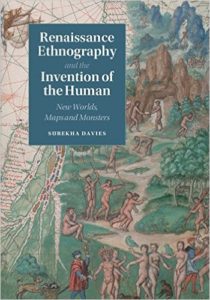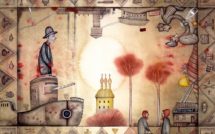
 In recent months, Donald Trump has vowed to make America great again, threatened to deport millions of illegal immigrants, made implausible links between refugees, Muslims, and terrorists, questioned the purpose of both NATO and the European Union, threatened to revive the Dakota Access Pipeline, and rid the White House website of references to anything to do with LGBTQ issues and climate change. Echoes of this intolerant nationalism can be heard in the UK and most states in Europe to a greater or lesser extent. Against this agenda, Surekha Davies’s Renaissance Ethnography, exploring the representation of the New World on Old World maps, seems more timely than it might have been a year ago. It is a reminder that the national and corporate identities of the United States and most other countries in North and South America were fashioned by Europeans in a way that placed them at the top of a Renaissance hierarchy of humanity, and actively demoted Amerindians to its base. This Renaissance fashioning marked the beginning of a colonial process that remains visible today. While the one hundred-fifteenth US Congress is more racially diverse than its predecessor, it will remain overwhelmingly white, male, middle-class, heterosexual, and Christian, more so among Republicans than Democrats.
In recent months, Donald Trump has vowed to make America great again, threatened to deport millions of illegal immigrants, made implausible links between refugees, Muslims, and terrorists, questioned the purpose of both NATO and the European Union, threatened to revive the Dakota Access Pipeline, and rid the White House website of references to anything to do with LGBTQ issues and climate change. Echoes of this intolerant nationalism can be heard in the UK and most states in Europe to a greater or lesser extent. Against this agenda, Surekha Davies’s Renaissance Ethnography, exploring the representation of the New World on Old World maps, seems more timely than it might have been a year ago. It is a reminder that the national and corporate identities of the United States and most other countries in North and South America were fashioned by Europeans in a way that placed them at the top of a Renaissance hierarchy of humanity, and actively demoted Amerindians to its base. This Renaissance fashioning marked the beginning of a colonial process that remains visible today. While the one hundred-fifteenth US Congress is more racially diverse than its predecessor, it will remain overwhelmingly white, male, middle-class, heterosexual, and Christian, more so among Republicans than Democrats.
The aim of Davies’s study is to show how Renaissance maps of the sixteenth and early seventeenth centuries illustrated human variation across the globe as mapmakers, diplomats, soldiers, merchants, and travelers understood it, and how they contributed to discourses in which the New World was invented and represented. She does this across eight chapters, marshalling an impressive volume of material, mainly maps and atlases preserved in collections across Europe and the US, but also items like letters, travelers’ accounts, and memoirs. Some of this material is difficult to access: chapter eight concludes with a brief, but amusing account of consulting maps hung in the Bibliothèque nationale de France using a ladder and a lamp.
The first chapter presents a clear account of the ways in which human diversity had been explained in medieval Christian Europe. Davies draws on humoral and behavioral theories, conceptions of monstrosity, the illustrations on the edges of mappaemundi, and popular travel accounts attributed to Marco Polo and John Mandeville. The classical, Biblical, and patristic sources cited will be familiar to anyone with an interest in these areas, but the chapter is helpful in providing a reader with context. One important medieval cosmological structure–the great chain of being–is missing. It was this chain that confirmed the boundaries between the divine, the human, the rest of the natural world, and the demonic. Monstrosity lay at the boundary of the human and the natural world, and that had consequences for an interpretation of human or human-like monstrosity because the boundary was immutable. Other ways of contextualising human variation and monstrosity would have been later medieval and sixteenth-century demonology and the emblem books popular in Jacobean England. Like many of the peoples of the New World, witches occupied the margins of humanity (being idolatrous, dishonorable, and operating beyond town or village boundaries), and they were often depicted (but not often described) as naked; like the cannibals, they were believed to be anthropophagous. It would be interesting to see how Davies’s book might inform research into the role of witches in the European imagination–with the exception of the work of Charles Zika and Lyndal Roper’s lecture collection The Witch in the Western Imagination (2012), for example, this is an area of witchcraft history which is less well served.
Chapter two introduces the reader to the main European regions of cartographic production: Portugal, Seville, the Rhineland, Normandy, Antwerp, and Amsterdam. Davies highlights the strikingly wide circulation of mapmakers, the artists who illustrated the maps and the maps themselves. As she points out, the sixteenth and early seventeenth centuries saw constant religious conflict, often in the form of warfare, and yet confessional difference did not stand in the way of the movement of mapmakers, the utility of source materials, the imitation of maps, or the adoption of a common iconography to indicate key parts of the New World. This is a common theme throughout Renaissance Ethnography, even in chapters that deal with parts of the Americas, which were colonised by states with a clear agenda of religious conversion.
There is an overarching chronological structure to the remaining six chapters determined by the exploration and colonization of South and North America. Chapters three and four focus on Brazil, the first region to be given a clear identity among Europeans. Davies does a great job of showing how mapmakers contributed to the invention of Brazil. She is sensitive to the translation of hearsay about un-encountered tribes like the “canibales”–reported circumspectly in the iconic texts of exploration such as Columbus’s Diario (1492-3)–into apparently real cannibals on maps. Although the cannibalistic representation of the peoples of Brazil and the neighboring areas was contested as ill-informed in the sixteenth century, it became fixed to the region on maps and in the early modern imagination. It was the bestial act of man-eating that justified their enslavement in the eyes of Iberian policy-makers. One wonders what might have happened had Spanish and Portuguese mapmakers chosen to adapt one of the many peaceful, confirmed activities recounted by explorers as a motif for Brazil. We find Norman mapmakers influencing policy in a different direction. Rejecting the common iconographic stereotype of the cannibal, they did promote the Tupinambá tribes of Brazil as potential peaceful trading partners in maps gifted to French kings. It was hoped, vainly, that the French court and government would sponsor their mercantile endeavors.
Davies demonstrates that other areas of the New World came to be defined by motifs other than the cannibal. Early sixteenth-century travel writings were the source of the giants–the Patagonians–who came to emblematize Patagonia; and Ralegh’s account of his expedition to Guiana in search of El Dorado, published in 1596, led to headless men and Amazons as symbols for that region. In both cases, the writers reported local knowledge, which they could not claim to testify themselves, but which mapmakers transformed into ethnographic detail. On the other hand, views and plans of the cities of Tenochtitlán and Cuzco described in accounts of the early explorations to the New World were used to identify Mexico and Peru, respectively. In the process of establishing recognizable motifs for different regions, it was confirmed that the latitude of Patagonia and Guiana engendered monstrous or wondrous beings who lacked humanity. Location and climate might have the same monstrous consequences for Europeans traveling there. The peoples of Mexico and Peru, on the other hand, were more like the explorers. They had developed a degree of civility, including rudimentary clothing and political systems, and could therefore be more readily converted to Christianity. The diversity of humanity depicted on maps across Europe ranged from the monstrous to the civil. Although some of them had not been verified by witness testimony and some of it might be questioned by readers and other travelers, the established representations of this diversity were given general credence by way of reference to ancient, scriptural, and medieval sources, as well as travelers’ accounts.
Davies is, of course, sensible of the complications in reading stereotypes. She is careful to acknowledge that mapmakers always had a choice of sources from which to establish motifs and invent regional identities. Eventually, however, the sheer volume and diversity of early modern knowledge about the world undermined the function of the maps. In the final chapter about America’s place in the world, Davies shows how new knowledge about the customs, costumes, and natural history of a larger range of peoples and new literary and artistic genres, like costume books, made early seventeenth-century maps of the New World unwieldy for display, policy or navigation, and travel. Illustrated travel books were more portable and could be illustrated and updated more often to accommodate advances in knowledge and understanding. Even though the maps lost their claim to ethnographic authority at this time, they had established a hierarchy of humanity headed by Europe (where the inhabitants were civil and highly skilled in all things), followed by Asia (which could resemble Europe, but which also included despotic states the Ottoman Empire) and Africa (home of the pyramids, but also simple inhabitants), and propped up by America (home of relatively uncivil idolators). While we might revise this hierarchy to position modern North America at the top and Africa at the bottom, one could argue that it retains a cultural and geo-political resonance for Europeans today, however fragile and tenuous.
The full title of the book Renaissance Ethnography and the Invention of the Human, is misleading. Nothing in the text suggests that the human needed to be invented in the Renaissance, and it is not an argument that Davies pursues. She does, however, show how the encounters with the peoples of the New World found functional expression in the early maps of the region. This expression was mediated by the mapmakers and their clients who helped to invent and position regional identities through their own form of ethnography. Maps that are placed at the center of early modern European history need to make sense of the expanding world and exploit it effectively.
Reviewed by Jonathan Durrant, University of South Wales
Renaissance Ethnography and the Invention of the Human: New Worlds, Maps and Monsters
by Surekha Davies
Publisher: Cambridge University Press
Hardcover / 380 pages / 2016
ISBN: 9781107036673
To read more book reviews, please click here.
Published on March 1, 2017.




